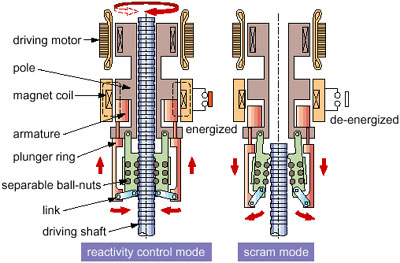The advanced marine reactor, MRX, has adopted some innovative technologies, one of which is an in-vessel control rod driving mechanism (INV-CRDM) (Fig. 2-4). Since this mechanism is installed inside the reactor vessel, it differs from those of existing power LWRs. This eliminates the possibility of a reactivity accident due to the ejection of a control rod, so safety can be improved. Adopting this mechanism enables the reactor system to be compact and simple while improving economy and reliability. However, since it is located inside the reactor vessel, this mechanism has to function infallibly in the severe environment imposed by the high-temperature and high-pressure water of the primary loop.
The INV-CRDM is driven by an electric motor; it is not hydraulically powered. An electric motor can adjust the position of a control rod more precisely and quickly in response to load changes than can a conventional hydraulically powered one. JAERI is at the forefront in the development of the motor-driven INV-CRDM.
To date, there is no published data for the components needed for this device, such as the driving motor, ball bearings, latch mechanism, etc., all of which must function under extremely harsh conditions. JAERI, therefore, has developed this control rod drive mechanism by selection of materials, trial manufacture, characteristic tests of each component, and functionality and durability tests of a full-scale model in high-temperature water. The test results revealed that this design can satisfy the performance and design requirements. Development of the motor driven INV-CRDM has been completed. It may now be adopted in the design of the advanced marine reactor, MRX. Additionally, this device can be used in an integral type or compact reactor. |


